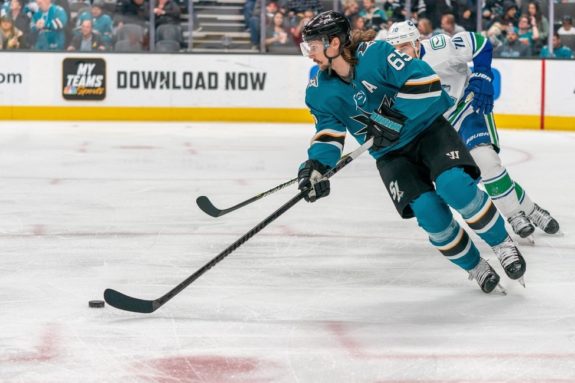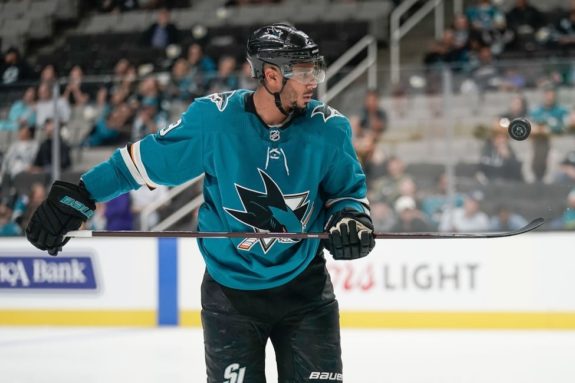
 Cami Hong
The Hockey Writers
Cami Hong
The Hockey Writers
35
Reads
0
Comments
Analyzing the Sharks’ Top-Ranked Penalty Kill
The San Jose Sharks have had a down season. They had an up and down first two months of the season, with four wins in October followed by a stellar November. After another cold streak in December, management fired head coach Peter Deboer, but their season continued to yo-yo.
Injuries were a factor. First, captain Logan Couture broke his ankle and missed 17 games, then Tomas Hertl tore his ACL, ruling him out for the rest of the season. Finally, Erik Karlsson broke his thumb in February, which also ruled him out for the season.

The only bright spot of the Sharks’ season, besides a strong November, has been their penalty kill, which ranks first in the league at 85.7%. The Edmonton Oilers have the second best penalty kill at 84.4%. It’s a considerable improvement over last season when they ranked 15th with an 80.8% rate.
The Numbers
The penalty kill had a lot of practice through the first part of the season when the Sharks were the most penalized team in the league, and Evander Kane led the team in penalty minutes. However, they have improved to third in with 273 penalty minutes.
Related: Top 5 Sharks Trades Under Doug Wilson
The league’s top four penalty kills have a winning percentage of over .500: The Oilers are at 84.4%, the Boston Bruins at 84.2%, the Carolina Hurricanes at 84.0% and the Arizona Coyotes at 82.7%. All four teams are in the playoff hunt and have a penalty kill that averages similar to playoff teams from past seasons, while the Sharks’ penalty kill rate is the highest since the Anaheim Ducks in 2015-16.

The Sharks are no longer the most penalized team in the league but they are averaging the most penalty minutes since 2012-13 when they averaged 10:51. In 2019-20, they are averaging almost 11 minutes in penalties and have taken 279 penalties so far this season. But even with that extra time of the penalty kill, it has been the players that have made the penalty kill what it is.
The Personnel
Melker Karlsson and Barclay Goodrow, before he was traded, were the forwards on the top penalty kill unit, with stars Couture, Kane and Hertl on the second and third units. Beside a few other depth players like Marcus Sorensen or Joel Kellman, not much of the penalty kill has changed from the past few seasons. Continuing to use more defensive-minded players, like Karlsson and Goodrow, they have started to develop strong defensive units to match the defensemen on the ice.
By using defensive minded forwards they are able to not rely as much on Erik Karlsson, Brent Burns, or Marc-Edouard Vlasic. These players are able to collapse near the net, take the place on a defenseman if they go out and chase, or get back during a play at or below the goal line.
Related: Sharks Are Still Thornton’s Best Shot at a Cup
When the Sharks brought Bob Boughner back to the coaching staff, there was not expected to be much of a change in the penalty kill. When Boughner was previously an assistant coach with the Sharks, he was in charge of the penalty kill and over the two seasons they averaged just over 80%.
The biggest surprise of the penalty kill is the difference between seasons despite a similar coaching staff. The Sharks’ penalty kill has averaged 80.6% since 2015-16, except for the 2017-18 season when it was 84.8%, second in the league behind the Los Angeles Kings. Before the 2017-18 season Boughner had just left the Sharks to coach the Florida Panthers, so Rob Zettler was the coach in charge of the defense with Steve Spott still coaching the offense.

In Zettler’s first season, he didn’t make a lot of change to the defense but drastically improved the penalty kill. Under Boughner, it had been operating at 80.7% effectiveness for 2016-17, however under Zettler they were 84.8% effective, despite spending about the same average amount of time shorthanded per game at 4:25.
Previously under Deboer, Spott and Boughner, the Sharks were more likely to have a top-10 power play than penalty kill, which had always been middle of the pack, and the same could be said for their power play. With more big-name offensive players, the penalty kill might seem like an afterthought for fans.
Even with that one bright spot this season, it has still been a down year for more reason than one. Whether it was bad plays, injuries, or other circumstances this season from about December has been a season to forget.
Can the Sharks sustain their top penalty kill in future seasons? Maybe. As this season showed us, statistics from one year to another can change drastically and the Sharks’ penalty kill is not exception. An example of this is the Sharks goals for (GF). Last year, the team was second in GF, but this season they are 27th, after losing Joe Pavelski who was a major part of last season’s team.
The post Analyzing the Sharks’ Top-Ranked Penalty Kill appeared first on The Hockey Writers.
Popular Articles

















































 Blackhawks Chicago
Blackhawks Chicago Panthers Florida
Panthers Florida Penguins Pittsburgh
Penguins Pittsburgh Rangers New York
Rangers New York Avalanche Colorado
Avalanche Colorado Kings Los Angeles
Kings Los Angeles Maple Leafs Toronto
Maple Leafs Toronto Bruins Boston
Bruins Boston Capitals Washington
Capitals Washington Flames Calgary
Flames Calgary Oilers Edmonton
Oilers Edmonton Golden Knights Vegas
Golden Knights Vegas Flyers Philadelphia
Flyers Philadelphia Senators Ottawa
Senators Ottawa Lightning Tampa Bay
Lightning Tampa Bay Islanders New York
Islanders New York Sabres Buffalo
Sabres Buffalo Red Wings Detroit
Red Wings Detroit Devils New Jersey
Devils New Jersey Hurricanes Carolina
Hurricanes Carolina Stars Dallas
Stars Dallas Jets Winnipeg
Jets Winnipeg Blue Jackets Columbus
Blue Jackets Columbus Predators Nashville
Predators Nashville Wild Minnesota
Wild Minnesota Blues St. Louis
Blues St. Louis Mammoth Utah
Mammoth Utah Sharks San Jose
Sharks San Jose Ducks Anaheim
Ducks Anaheim Canucks Vancouver
Canucks Vancouver


